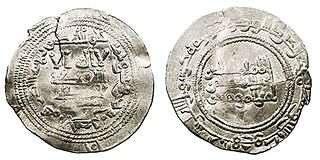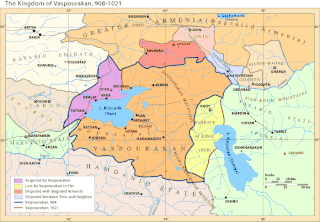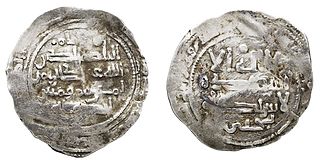
ʿAbd al-Raḥmān ibn Muḥammad ibn ʿAbd Allāh ibn Muḥammad ibn ʿAbd al-Raḥmān ibn al-Ḥakam al-Rabdī ibn Hishām ibn ʿAbd al-Raḥmān al-Dākhil, or simply ʿAbd al-Raḥmān III, was the Umayyad Emir of Córdoba from 912 to 929, at which point he founded the Caliphate of Córdoba, serving as its first caliph until his death. Abd al-Rahman won the laqab (sobriquet) al-Nāṣir li-Dīn Allāh in his early 20s when he supported the Maghrawa Berbers in North Africa against Fatimid expansion and later claimed the title of Caliph for himself. His half-century reign was known for its religious tolerance.
The 1000s was a decade of the Julian Calendar which began on January 1, 1000, and ended on December 31, 1009.
The 1010s was a decade of the Julian Calendar which began on January 1, 1010, and ended on December 31, 1019.

Year 1021 (MXXI) was a common year starting on Sunday of the Julian calendar.
Year 929 (CMXXIX) was a common year starting on Thursday of the Julian calendar.
Abu al-Qasim Muhammad ibn Abbad was the eponymous founder of the Abbadid dynasty; he was the first independent Muslim ruler of Seville in Al-Andalus ruling from 1023 until his death in 1042.

Abū al-Ḥasan ʿAlī ibn al-Ḥākim, better known with his regnal name al-Ẓāhir li-Iʿzāz Dīn Allāh, was the seventh caliph of the Fatimid dynasty (1021–1036). Al-Zahir assumed the caliphate after the disappearance of his father al-Hakim bi-Amr Allah.
Sitt al-Mulk was a Fatimid princess. After the disappearance of her half-brother, the caliph al-Hakim bi-Amr Allah, in 1021, she was instrumental in securing the succession of her nephew Ali az-Zahir, and acted as the de facto ruler of the state until her death on 5 February 1023.
This is a timeline of notable events during the period of Muslim presence in Iberia, starting with the Umayyad conquest in the 8th century.
The Banu Tujib, the Tujibids or Banu al-Muhajir, were an Arab dynasty on the Upper March of Al-Andalus active from the ninth to the eleventh centuries. They were given control of Zaragoza and Calatayud by the Umayyads as a counterweight to the independence-minded Muwallad nobility of the region. In Zaragoza, they developed a degree of autonomy that served as the precursor to their establishment of an independent Taifa of Zaragoza after the collapse of the Caliphate of Córdoba. They ruled this taifa from 1018 until they were expelled by another Arab dynasty, the Banu Hud, in 1039. An exiled junior line of the family, known as the Banu Sumadih, established themselves as rulers of the Taifa of Almería, which they held for three generations, until 1090.
Toda Aznárez, known as Toda of Pamplona, was queen of Pamplona by her marriage to Sancho I. She ruled the kingdom as regent during the minority of her son García Sánchez I from 931. She was herself descended from the previous royal dynasty, Aritza.

The Emirate of Córdoba or Umayyad Emirate of Córdoba was a medieval Islamic kingdom in the Iberian Peninsula.
The 1020s was a decade of the Julian Calendar which began on January 1, 1020, and ended on December 31, 1029.

The Taifa of Córdoba was an Arab taifa which was ruled by the Banu Jawhar that replaced the Umayyad Caliph as the government of Córdoba and its vicinity in 1031.

The Taifa of Algeciras was a medieval Muslim taifa kingdom in what is now southern Spain and Gibraltar, that existed from 1035 to 1058.

Yahya ibn Ali ibn Hammud al-Mu'tali was Caliph of Cordoba in the Hammudid dynasty of the Al-Andalus during two periods, from 1021 to 1023 and from 1025 to 1026. He was the son of caliph Ali ibn Hammud.
Ali ibn Hammud al-Nasir was the sixth Caliph of Córdoba from 1016 until his death. He was a member of the Hammudid dynasty of the Al-Andalus.
Al-Amīr al-Mukhtār ʿIzz al-Mulk Abū ʿAbd Allāh Muḥammad ibn Abīʾl Qāsim ʿUbayd Allāh ibn Aḥmad ibn Ismāʿīl ibn ʿAbd al-Azīz al-Ḥarranī al-Musabbiḥī al-Kātib, commonly known simply as al-Musabbihi, was a Fatimid historian, writer and administrative official. He is known to have authored some 40,000 pages of manuscripts dealing with an array of topics, including history, psychology, law, grammar, sexology and cooking. Akhbār Miṣr, a contemporary chronicle of Egyptian history and news, was among al-Musabbihi's well-known works. However, like the vast majority of al-Musabbihi's works, only fragments of Akhbār Miṣr survived; most of his writings disappeared not long after his death.

Abd al-Rahim ibn Ilyas ibn Ahmad ibn al-Mahdi was a member of the Fatimid dynasty who was named heir-apparent by the caliph al-Hakim bi-Amr Allah in 1013. When al-Hakim was murdered in 1021, he was sidelined in favour of al-Hakim's son, Ali al-Zahir, arrested and imprisoned. He died in captivity, officially by his own hands, or assassinated by the real power behind al-Zahir's throne, the princess Sitt al-Mulk.








